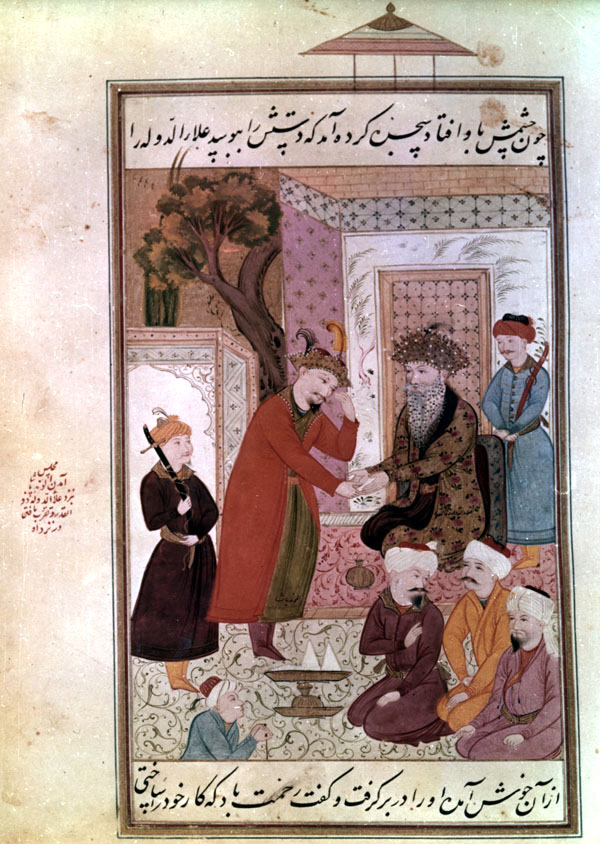Alvand Mirzā Torkmān Visits ʿAlā al-Dowla Ẕuʾl-Qadar
In the year 907/1501 Esmāʿil was consolidating his position in northwestern Iran. After subjugating the province of Širvān (see Ms. L, folio 62v), and defeating Sultan Ḥoseyn Bārāni the previous year (see Ms. M, folio 42v), he turned his attention towards the Turkman seat in Tabriz. When the Turkman ruler Rostam Šāh died he was survived by four sons. Family intrigues that pitted Āq Qoyunlu against Qarā Qoyunlu resulted in the assaination of the two eldest sons and allowed the third son Alvand Mirzā (also known as Mirzā Alvand Torkmān and Alvand Pāšā) to attain his father’s throne. Eskandar Monshi states that it was Alvand who first made threatening gestures against Esmāʿil by moving with a large force to Naḵčevān with the intent of taking Širvān, but theʿālām-ārā-ye šāh esmāʿil offers a different chain of events. Here it is stated that when Alvand received word that Esmāʿil was moving in his direction with a large force, he dispatched a letter to Esmāʿil with a peace iniative. Esmāʿil’s response was conditional on Alvand’s embracing Shiʿism and becoming his vassal. Alvand refused, and a battle ensued which according to Monshi took place at Šarur, near Naḵčevān. Although Alvand reportedly had 20,000 troops and the qezelbāš only 7,000, both sources agree on the outcome of the battle, that Alvand was readily defeated. Esmāʿil was unable to catch up with the fleeing Alvand, returned and entered Tabriz in triumph, where he was coronated shah and proclaimed Shiʿism the state religion (see Ms. L, folio 74 and M, folio 48v).
Alvand fled to Diār Bakr and was cordially received by ʿAlā al-Dowla Ẕuʾl-Qadar, who owed a debt to the Turkman rulers of Tabriz. This initial meeting of the two is the scene depicted here. Alvand received a force of 20,000 fresh troops from ʿAlā al-Dowla Ẕuʾl-Qadar with which to again confront Esmāʿil. Alā al-Dowla Ẕuʾl-Qadar, ruler of Marʿaš, Albestān, and Diār Bakr, is represented here with a bejeweled white beard, jewel studded crown, and brocaded coat, seated on a carpet before a tiled pavilion, with his arms outstretched to greet the visitor. Alvand, dressed in a vermillion topcoat and jewelled headgear, stands before the Ẕuʾl-Qadar and gestures a salam. Retainers holding swords in ceremonial position are shown in hieratic scale a few steps behind their respective masters. Three observers are seated in the lower right foreground, and a fourth almost caricatured man with a walking stick, is shown in profile in the lower left, cropped at the waist by the frame.
Location: Reza Abbasi Museum, Tehran, No.77.1.7, folio 51.
Folio size: 35.6 x 21.6 cm. wide (after Mahboubian)
Painting: 23.2 including cupola in upper margin x 13.1 cm. wide (after Mahboubian)
Written surface: 22.5 cm. (scaled) x 13.1 cm. wide. One line of text above and below the painting. Frame encloses painting and text; cupola above the tiled pavilion protrudes beyond the frame into the upper margin.
Inscriptions: A marginal inscription in red describes the event depicted. Inscriptions, one in red and the other in black identify two of the figures as Alvand Pāšā and ʿAlā al-Dowla Ẕuʾl-Qadar.
Painting references:
Mahboubian_1972, #923 folio 51 (not illustrated).
Text references:
See Muntaẓer-Ṣāḥeb_1970, p.63 for this event in the History of Shah Esmāʿil.
See Savory, SA_1979, pp.44-45 for this event in the History of Shah ʿĀbbās.
Robert Eng
Last Updated: October 19, 2011 | Updated:
December 2, 2010 | Originally published: March 28, 2002
